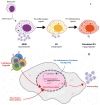Host Restriction Factors Modulating HIV Latency and Replication in Macrophages
- PMID: 35328442
- PMCID: PMC8951319
- DOI: 10.3390/ijms23063021
Host Restriction Factors Modulating HIV Latency and Replication in Macrophages
Abstract
In addition to CD4+ T lymphocytes, myeloid cells and, particularly, differentiated macrophages are targets of human immunodeficiency virus type-1 (HIV-1) infection via the interaction of gp120Env with CD4 and CCR5 or CXCR4. Both T cells and macrophages support virus replication, although with substantial differences. In contrast to activated CD4+ T lymphocytes, HIV-1 replication in macrophages occurs in nondividing cells and it is characterized by the virtual absence of cytopathicity both in vitro and in vivo. These general features should be considered in evaluating the role of cell-associated restriction factors aiming at preventing or curtailing virus replication in macrophages and T cells, particularly in the context of designing strategies to tackle the viral reservoir in infected individuals receiving combination antiretroviral therapy. In this regard, we will here also discuss a model of reversible HIV-1 latency in primary human macrophages and the role of host factors determining the restriction or reactivation of virus replication in these cells.
Keywords: HIV; MDM; macrophage polarization; macrophages; restriction factors; transcription factors.
Conflict of interest statement
The authors declare no conflict of interest.
Figures


References
Publication types
MeSH terms
Grants and funding
LinkOut - more resources
Full Text Sources
Other Literature Sources
Medical
Research Materials

